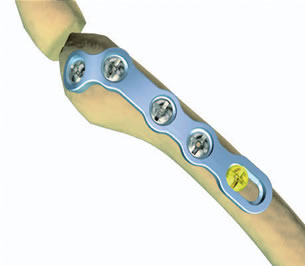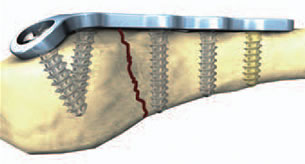New Metacarpal Plate Design Conforms Better to Patient’s Bone
Mimics software utilized in design of new hand plating system.
Latest News
February 28, 2008
By Susan Smith
 Image courtesy of Materialise andStryker |
Metacarpal bone fractures are generally treated with standard plating systems designed by orthopedic device suppliers, which don’t always conform to the patient’s anatomy. Professor Dr. Stockmans of AZ Groeninge, Belgium found that in the treatment of some peri-articular fractures, this could be rather problematic since the standard plates available in the market could not provide a stable anchor for the bone during healing. Often surgeons had to bend the implant during surgery to get a better fit onto the patient’s bone, thereby extending the time the patient was in surgery. Using Mimics’ software from Materialise ]Leuven,Belgium; materialise.com], Dr. Stockmans changed the design of a hand plating system so that it would fit optimally to the shape of the patient’s bone.
The example given was that of a fracture of the fifth metacarpal (“V”), which connects the little finger to the wrist. Commonly known as a “boxer’s fracture,” it generally occurs at the neck of the bone when punching an immovable object with a closed fist. The end of the fifth metacarpal will then suffer the impact and can break.
This type of fracture needs to be stabilized in order to heal. Orthopedic device companies didn’t have plates with the type of contouring needed to ensure that the bone could be stabilized during healing. As a result, Dr. Stockmans teamed up with medical device company Stryker and turned to Mimics to design an anatomically correct plate that would be shaped to the patient’s individual metacarpal.
 Image courtesy of Materialise andStryker |
The process involved importing CT scanned images of metacarpal V and an STL file of the implant into Mimics. Using patient data from his own patient database, Dr. Stockmans created 3D reconstructions of the metacarpal, virtually positioning the plate on the bone as if it were real-life surgery. The process revealed how the plate did not fit properly, so Dr. Stockmans used the cutting tools in Mimics’ simulation module to cut the standard plate into pieces, then repositioned the various parts so that the plate conformed to the shape of the bone. He then merged the different pieces into an anatomically correct metacarpal V plate prototype.
For Dr. Stockmans, the newly designed plate offered a vast improvement over previous plate technology. An added bonus was the fact that Dr. Stockmans and Stryker were able to complete the entire process from concept to market, in less than three months, which normally would have taken one to two months longer. Generally, these types of designs evolve through trial and error, as the company manufactures prototypes that undergo a number of design changes due to anatomical incompatibilities that become evident during cadaveric testing. The use of Dr. Stockmans’ patient specific data, coupled with Mimics’ surgery simulation feature that allows you to verify the design and make changes virtually, saved an enormous amount of time in the design process.
Subscribe to our FREE magazine, FREE email newsletters or both!
Latest News
About the Author
DE’s editors contribute news and new product announcements to Digital Engineering.
Press releases may be sent to them via [email protected].






